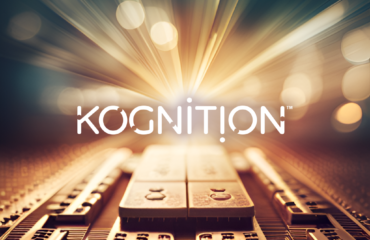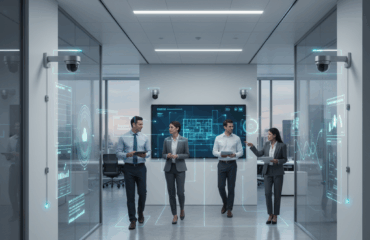
Transform your commercial property into a high-performing asset with intelligent security technology
Commercial real estate owners are discovering that smart building security AI isn’t just about protection—it’s about profit. While traditional security systems are viewed as necessary expenses, intelligent security solutions have emerged as powerful revenue drivers that can increase Net Operating Income (NOI) by 15-30% and significantly boost Net Asset Value (NAV).
In today’s competitive CRE market, property owners who fail to leverage building automation security and advanced real estate technology investment strategies risk falling behind. This comprehensive guide reveals exactly how commercial property security systems powered by AI deliver measurable financial returns that justify every dollar invested.
Understanding the Financial Impact of Smart Building Security AI
The paradigm shift from reactive security to predictive, intelligent systems represents one of the most significant opportunities for CRE owners to enhance property performance. Smart building security AI systems don’t just reduce security incidents—they fundamentally transform how buildings operate, creating new revenue streams while dramatically reducing operational costs.
The NOI Enhancement Framework
Net Operating Income improvement through intelligent security systems occurs across five primary categories:
Direct Cost Reductions: Automated systems reduce staffing requirements by 40-60%, while predictive maintenance prevents costly emergency repairs. Energy management integration can cut utility costs by 15-25%.
Revenue Protection: AI-powered systems prevent revenue loss from theft, vandalism, and unauthorized access. Properties report 70-90% reductions in security incidents that could impact tenant operations.
Premium Positioning: Buildings with advanced security command 5-15% higher rents and experience 25% lower vacancy rates, as tenants increasingly prioritize safe, intelligent work environments.
Insurance Optimization: Comprehensive AI security systems can reduce property insurance premiums by 5-10%, while providing detailed incident documentation that minimizes claim disputes.
Operational Efficiency: Integrated building automation security streamlines property management, reducing administrative costs by 20-30% through automated reporting, compliance monitoring, and maintenance scheduling.
7 Ways AI Security Increases Building NOI
1. Workforce Optimization and Cost Reduction
Traditional security models require 24/7 human monitoring, representing one of the largest operational expenses for commercial properties. Smart building security AI transforms this cost structure through:
- Automated Monitoring: AI systems provide continuous surveillance without breaks, sick days, or shift changes, reducing security personnel costs by $150,000-300,000 annually for mid-size buildings
- Intelligent Triage: Systems prioritize real threats, allowing remaining security staff to focus on high-value activities rather than false alarms
- Remote Management: Centralized monitoring capabilities enable one team to oversee multiple properties, creating economies of scale
Financial Impact: $200,000-500,000 annual savings for buildings over 100,000 square feet
2. Energy Management Integration
Building automation security systems that integrate with HVAC, lighting, and power management create substantial utility savings:
- Occupancy-Based Controls: AI adjusts environmental systems based on real-time occupancy data, reducing energy consumption by 15-25%
- Predictive Optimization: Machine learning algorithms optimize energy usage patterns, preventing waste while maintaining tenant comfort
- Demand Response Programs: Intelligent systems participate in utility demand response programs, generating additional revenue streams
Financial Impact: $0.50-1.20 per square foot annual savings
3. Predictive Maintenance Revolution
AI-powered building systems continuously monitor equipment health, preventing costly emergency repairs and extending asset lifecycles:
- Early Warning Systems: Detect potential failures weeks or months in advance, allowing for planned maintenance during off-hours
- Vendor Optimization: Data-driven insights enable better vendor negotiations and maintenance contract optimization
- Asset Longevity: Proper monitoring and maintenance extend equipment life by 20-40%
Financial Impact: 30-50% reduction in emergency maintenance costs
4. Insurance Premium Optimization
Insurance carriers increasingly recognize the risk reduction benefits of comprehensive AI security systems:
- Premium Reductions: Properties with advanced security systems qualify for 5-10% insurance premium discounts
- Claim Prevention: Fewer incidents mean fewer claims, leading to better renewal terms and experience modifications
- Documentation Benefits: AI systems provide detailed incident documentation, reducing claim disputes and legal costs
Financial Impact: $50,000-200,000 annual savings depending on property size and value
5. Tenant Retention and Premium Pricing
Modern tenants, particularly in the post-pandemic era, prioritize safety and intelligent building features:
- Retention Improvement: Properties with advanced security experience 25% higher tenant retention rates
- Rent Premiums: Smart building features command 5-15% rent premiums over comparable properties
- Faster Leasing: Advanced security features reduce average vacancy periods by 30-45%
Financial Impact: 3-8% increase in effective rent per square foot
6. Liability Risk Mitigation
AI security systems significantly reduce liability exposure through comprehensive monitoring and documentation:
- Incident Prevention: Proactive threat detection prevents incidents that could result in costly lawsuits
- Evidence Quality: High-definition recordings and detailed logs provide superior evidence in legal proceedings
- Compliance Automation: Systems ensure consistent compliance with safety and security regulations
Financial Impact: Avoided litigation costs of $100,000-1,000,000+ per prevented major incident
7. Data-Driven Revenue Optimization
Intelligent systems generate valuable data insights that drive additional revenue opportunities:
- Space Utilization Analytics: Optimize floor plans and common areas based on actual usage patterns
- Tenant Services: Offer premium security monitoring as a billable service
- Market Intelligence: Leverage foot traffic and activity data for retail tenant negotiations
Financial Impact: 2-5% increase in ancillary revenue streams
NAV Enhancement Through Security Technology Investment
Net Asset Value improvement through real estate technology investment extends beyond immediate NOI gains. Institutional investors and sophisticated buyers increasingly value properties with integrated technology infrastructure, creating substantial asset appreciation opportunities.
Market Valuation Premiums
Properties with comprehensive smart building security AI systems command market premiums through several mechanisms:
Technology Premium: Buildings with integrated security and automation systems sell for 10-20% more than comparable properties without these features.
Cap Rate Compression: Investors apply lower cap rates (0.25-0.75% reduction) to properties with stable, technology-enhanced NOI streams, directly increasing asset values.
Future-Proofing Value: Properties with robust technology infrastructure are better positioned for future upgrades and tenant demands, reducing obsolescence risk.
ESG and Sustainability Benefits
Environmental, Social, and Governance (ESG) considerations increasingly drive institutional investment decisions:
- Energy Efficiency: Integrated systems contribute to sustainability goals and green building certifications
- Social Responsibility: Enhanced security demonstrates commitment to tenant and visitor safety
- Governance: Automated compliance and reporting capabilities improve operational transparency
NAV Impact: 15-25% increase in asset value through combined NOI improvement and market premium effects
ROI Calculation Framework
Developing a comprehensive ROI analysis for commercial property security systems requires careful consideration of both hard and soft cost benefits. This framework provides CRE owners with the tools to build compelling investment justifications.
Initial Investment Analysis
System Costs:
- Hardware and software: $5k – $100k per year depending on sophistication level
- Installation and integration: $5k-100k depending on scale and depth of integration
- Training and setup: $10k-50k one-time cost
Ongoing Costs:
- Software licensing: $5k – $100k per facility annually depending on scale and sophistication level
- Maintenance and support: 10-15% of initial hardware cost annually
- Periodic upgrades: 15-20% of initial investment every 5-7 years
Benefit Quantification
Year 1 Benefits:
- Security staff reduction: $150k-400k
- Energy savings: $25k-120k
- Insurance premium reduction: $20k-100k
- Maintenance cost reduction: $30k-150k
Years 2-5 Cumulative Benefits:
- Tenant retention value: $200k-800k
- Rent premium capture: $300k-1,200k
- Additional revenue streams: $50k-200k
- Avoided liability costs: Variable but potentially substantial
ROI Calculation Models
Simple Payback Period:
Most building automation security investments achieve payback within 18-36 months through direct cost savings alone.
NPV Analysis:
Using a 7-10% discount rate, typical projects generate positive NPV of $2-5 million for buildings over 200,000 square feet over a 10-year analysis period.
IRR Calculations:
Internal rates of return typically range from 25-45% for comprehensive smart building security AI implementations, far exceeding most alternative investment opportunities.
Real-World Case Studies
Case Study 1: Class A Office Building – Chicago
Property Profile:
- 450,000 square feet
- Multi-tenant office building
- Premium downtown location
Investment:
- $2.1 million initial security AI system investment
- 18-month implementation timeline
Results:
- 32% reduction in security personnel costs ($280,000 annually)
- 22% decrease in energy costs ($195,000 annually)
- 15% insurance premium reduction ($85,000 annually)
- 95% tenant retention rate (up from 78%)
- 12% rent premium over comparable properties
Financial Impact:
- Annual NOI increase: $897,000
- 14-month payback period
- 38% IRR over 7-year hold period
Case Study 2: Mixed-Use Development – Austin
Property Profile:
- 680,000 square feet
- Retail, office, and residential components
- Urban infill development
Investment:
- $3.8 million comprehensive security and building automation system
- Integration with existing building systems
Results:
- 28% operational cost reduction across all building systems
- 40% reduction in security incidents
- 18% improvement in tenant satisfaction scores
- Premium positioning in competitive market
Financial Impact:
- NOI increase of 26% within 24 months
- Asset value appreciation of $18 million
- 31% IRR including sale proceeds
Case Study 3: Industrial Portfolio – Southeast Region
Property Profile:
- 12-property industrial portfolio
- 2.1 million total square feet
- Distribution and light manufacturing tenants
Investment:
- $4.2 million centralized security system across portfolio
- Phased 24-month implementation
Results:
- Centralized monitoring enabling 60% security staff reduction
- 45% decrease in theft and vandalism incidents
- Enhanced tenant retention through improved security
- Ability to command premium rents for secure facilities
Financial Impact:
- Portfolio NOI increase of 22%
- $12 million increase in portfolio valuation
- 29% blended IRR across all properties
Making the Investment Decision
For CRE decision-makers evaluating smart building security AI investments, several key factors should guide the decision-making process:
Financial Readiness Assessment
Cash Flow Analysis: Ensure adequate cash flow to support initial investment and ongoing operational changes during system integration.
Portfolio Strategy Alignment: Consider how security technology investment aligns with broader portfolio modernization and value enhancement strategies.
Financing Options: Explore technology financing options, including equipment financing, operating leases, and energy service company (ESCO) arrangements.
Implementation Timeline Considerations
Market Timing: Consider current lease expiration schedules and renewal opportunities to maximize rent premium capture.
Tenant Communication: Develop comprehensive tenant communication strategies to position security enhancements as value-added improvements.
Phased Deployment: Consider phased implementation approaches to manage cash flow and operational disruption.
Vendor Selection Criteria
Technology Integration: Ensure new systems integrate seamlessly with existing building automation and management platforms.
Scalability: Select solutions that can scale with property needs and accommodate future technology advances.
Support and Maintenance: Evaluate vendor support capabilities and long-term viability to protect investment value.
The evidence is clear: smart building security AI represents one of the most compelling real estate technology investment opportunities available to CRE owners today. With documented NOI improvements of 15-30% and substantial NAV enhancement potential, these systems transform security from a cost center into a profit driver.
As tenant expectations continue to evolve and competition intensifies, properties without intelligent security systems will increasingly struggle to attract and retain quality tenants while commanding premium rents. The question isn’t whether to invest in building automation security—it’s how quickly you can implement these systems to capture the substantial financial benefits they provide.
For CRE owners ready to maximize their property performance and asset values, smart building security AI offers a proven path to enhanced financial returns while providing the safety and efficiency that modern tenants demand.



